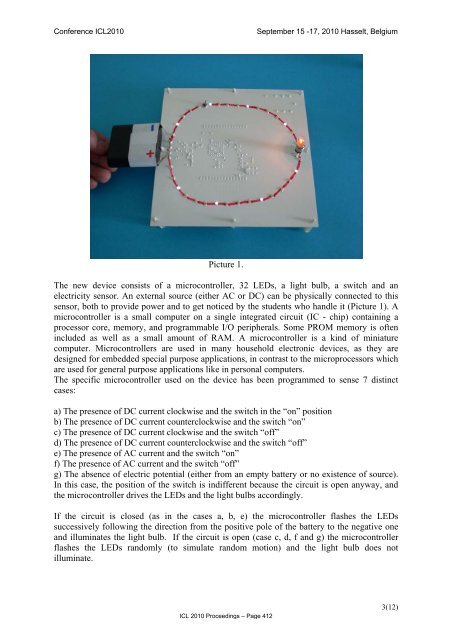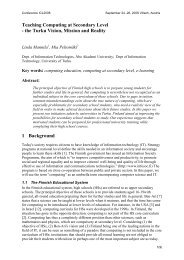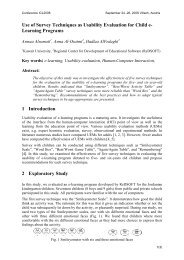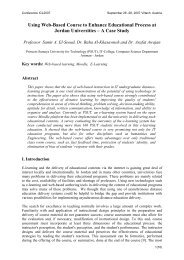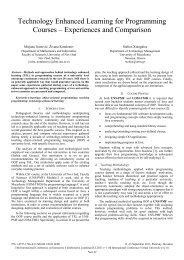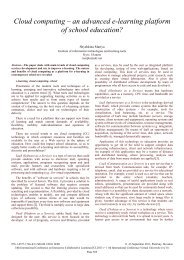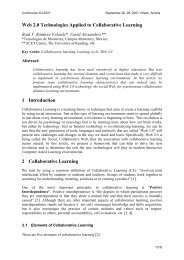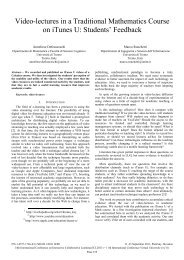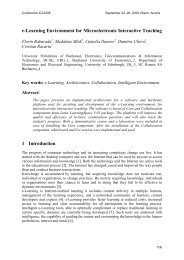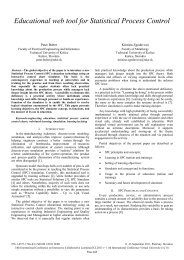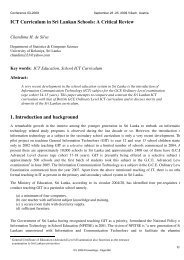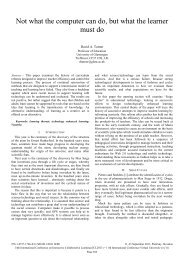Microcontrollers in Physics education: a circuit simulation ... - ICL
Microcontrollers in Physics education: a circuit simulation ... - ICL
Microcontrollers in Physics education: a circuit simulation ... - ICL
You also want an ePaper? Increase the reach of your titles
YUMPU automatically turns print PDFs into web optimized ePapers that Google loves.
Conference <strong>ICL</strong>2010<br />
September 15 -17, 2010 Hasselt, Belgium<br />
Picture 1.<br />
The new device consists of a microcontroller, 32 LEDs, a light bulb, a switch and an<br />
electricity sensor. An external source (either AC or DC) can be physically connected to this<br />
sensor, both to provide power and to get noticed by the students who handle it (Picture 1). A<br />
microcontroller is a small computer on a s<strong>in</strong>gle <strong>in</strong>tegrated <strong>circuit</strong> (IC - chip) conta<strong>in</strong><strong>in</strong>g a<br />
processor core, memory, and programmable I/O peripherals. Some PROM memory is often<br />
<strong>in</strong>cluded as well as a small amount of RAM. A microcontroller is a k<strong>in</strong>d of m<strong>in</strong>iature<br />
computer. <strong>Microcontrollers</strong> are used <strong>in</strong> many household electronic devices, as they are<br />
designed for embedded special purpose applications, <strong>in</strong> contrast to the microprocessors which<br />
are used for general purpose applications like <strong>in</strong> personal computers.<br />
The specific microcontroller used on the device has been programmed to sense 7 dist<strong>in</strong>ct<br />
cases:<br />
a) The presence of DC current clockwise and the switch <strong>in</strong> the “on” position<br />
b) The presence of DC current counterclockwise and the switch “on”<br />
c) The presence of DC current clockwise and the switch “off”<br />
d) The presence of DC current counterclockwise and the switch “off”<br />
e) The presence of AC current and the switch “on”<br />
f) The presence of AC current and the switch “off”<br />
g) The absence of electric potential (either from an empty battery or no existence of source).<br />
In this case, the position of the switch is <strong>in</strong>different because the <strong>circuit</strong> is open anyway, and<br />
the microcontroller drives the LEDs and the light bulbs accord<strong>in</strong>gly.<br />
If the <strong>circuit</strong> is closed (as <strong>in</strong> the cases a, b, e) the microcontroller flashes the LEDs<br />
successively follow<strong>in</strong>g the direction from the positive pole of the battery to the negative one<br />
and illum<strong>in</strong>ates the light bulb. If the <strong>circuit</strong> is open (case c, d, f and g) the microcontroller<br />
flashes the LEDs randomly (to simulate random motion) and the light bulb does not<br />
illum<strong>in</strong>ate.<br />
<strong>ICL</strong> 2010 Proceed<strong>in</strong>gs – Page 412<br />
3(12)


